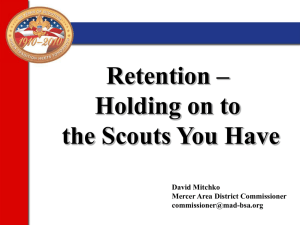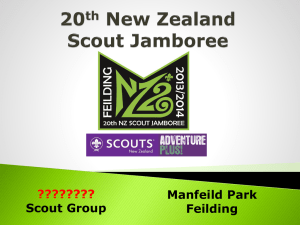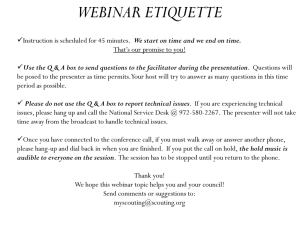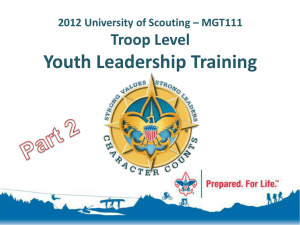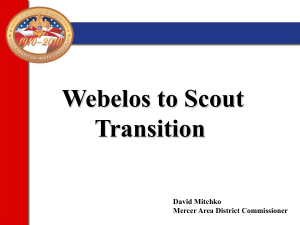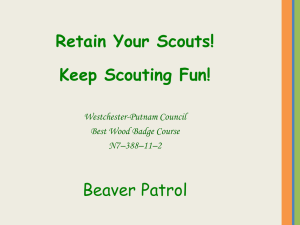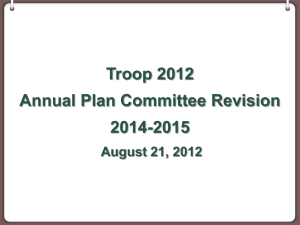Boy Scout New Parent Orientation
advertisement
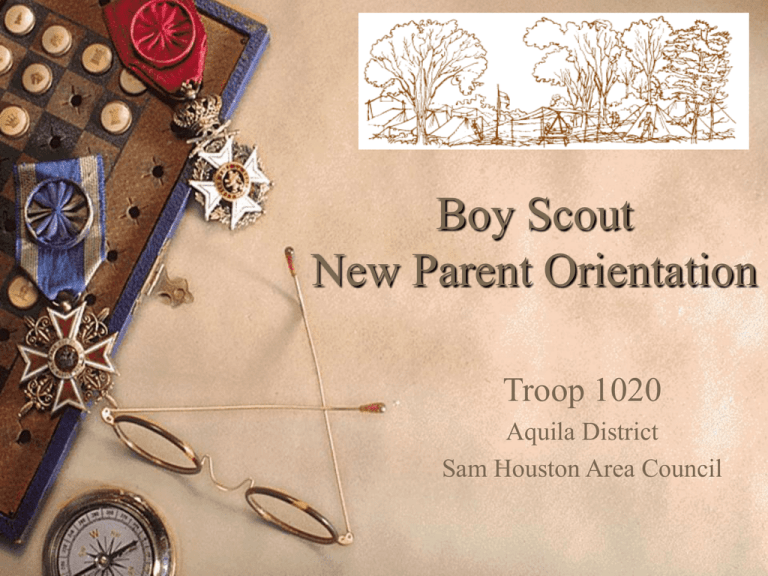
Boy Scout New Parent Orientation Troop 1020 Aquila District Sam Houston Area Council What Scouting is All About Aims of Scouting – three specific objectives: – character development, citizenship training & personal fitness. The principal focus is on the boys and in making it fun Agenda The Goals of Scouting History – – History of Scouting History of Troop 1020 Organization – – – BSA Organizational Overview Cub/Boy Scout Differences Troop Organization Leadership – – Scout’s Leadership within Troop Scout Leadership and Training Advancement – – Boy Scout Advancements First Class Emphasis Program Uniforms Recommended Equipment Troop Outings Other Important Stuff The Goals of Scouting The Aims of Boy Scouting – Character development – Citizenship training – Physical, mental, and emotional fitness Aims are Delivered by these Methods – – – – – – – – Ideals Patrols Outdoor Programs Advancement Personal Growth Leadership Development Uniform Associations With Adults History of Scouting The Beginnings of Scouting Movement – The 20th-century scouting movement was started by Robert Baden-Powell during the Boer War as a series of games and exercises to help men learn to live in the open under difficult conditions – Baden-Powell developed a book called “Aids to Scouting” as a way of training recruits. This book became an instant hit among boys – He conducted his first Boy Scout camp on Brownsea Island in 1907, and his book “Scouting for Boys” was published in 1908 – In England, Boy Scouts formally started on Jan. 24, 1908 History of Scouting in the USA – In the United States the Young Men's Christian Association (YMCA) had been running camps for boys since 1884. – In 1902 Ernest Thompson Seton founded the Tribe of Woodcraft Indians as a boy's organization. Three years later Daniel Carter Beard started a similar society called the Sons of Daniel Boone. – February 8th, 1910 William Boyce, inspired by unknown Scout in London, incorporated BSA working with YMCA and Seton – In 1910, Seton combined B-P “Scouting for Boys” and Woodcraft Manual to publish first BSA Handbook History of Troop 1020 First chartered in 2002 – Started with older Scouts – In 2003, the first new Scouts joined the Troop – Has remained a medium sized Troop with a firm commitment to work with each Scout Eagle Scouts: – Troop 1020 has seen XX Scouts complete their Eagle Rank – Three more are nearing completion BSA Organizational Overview The Scout Organization – National Council of Boy Scouts – Region – Local Council • Sam Houston Area Council – District • Golden Arrow – Chartered Organization • Pilgrim Lutheran Church • Chartered Organization Rep.: – Larry Smith American Youth Served in 2003 – Troop Committee • Current Committee Chair: – Stephen Mulvehill Cub Scouting 1,914,425 – Troop • Current Scoutmaster: – Gordon G. Start Boy Scouting Venturing 930,325 288,395 Troop Leadership Cub/Boy Scout Differences A Boy Scout Troop is not structured like a Cub Pack Boys have more responsibility – Planning, packing, setting up camp, cooking, activities – Scout is responsible for initiation of advancement – Parents cannot sign off. Adult Leaders (SM, ASM, CC, or CM), or Troop Leaders (SPL, ASPL, Troop Guide) are the only persons in the troop that that can sign off. We give the boy’s the chance to try and learn things, and make mistakes in a safe environment Patrol Method A Troop is made up of Patrols, A Troop is not divided into Patrols Each Patrol operates as a self-sufficient unit. Each Patrol is encouraged to develop their own identity with a Patrol flag and yell. Each Patrol will utilize a duty roster to distribute tasks across the team members and learn the value of teamwork Each Patrol will elect its own leadership (6 month term) to guide and manage the Patrol (Patrol Leader (PL) and Assistant PL) Patrol leaders will attend monthly planning meetings (PLC) and represent their patrol & are responsible for patrol communications. Adults do NOT run the patrols. Depending on attendance, patrols may be combined for activities. Patrol leaders will make mistakes. This is a learning activity. Each boy will get their opportunity to lead and to learn how to lead effectively. Scout’s Leadership within Troop Patrols (A Troop is made up of Scouts in Patrols) – Grouping of six or more boys who work together. Each patrol elects its own boy leader, called a patrol leader. Troop Youth Leaders – The troop is actually run by its boy leaders. With the guidance of the Scoutmaster and his assistants, they plan the program, conduct troop meetings, and provide leadership among their peers. – Senior patrol leader - top junior leader in the troop. He leads the patrol leaders' council and, in consultation with the Scoutmaster, appoints other junior leaders and assigns specific responsibilities as needed. – Assistant senior patrol leader - fills in for senior patrol leader in his absence. He is also responsible for training and giving direction to the quartermaster, scribe, troop historian, librarian, and instructors. – Troop Historian - collects and maintains troop memorabilia and information on former troop members. Scout’s Leadership within Troop Troop Youth Leaders (continued) – Librarian - keeps troop books, pamphlets, magazines, audiovisuals, and – – – – – – – – – merit badge counselor list available for use by troop members. Instructor - teaches one or more advancement skills to troop members. Chaplain Aide - assists in troop religious services and promotes religious emblems program. Junior assistant Scoutmaster - Scout at least sixteen (16) years old who supervises and supports other boy leaders as assigned. Patrol leader - gives leadership to members of his patrol and represents them on the Green Bar (a/k/a patrol leaders’ council). Assistant patrol leader - fills in for the patrol leader in his absence. Troop guide - advisor and guide to new Scout patrols. Den chief - works with a Cub Scout den as a guide. Quartermaster - responsible for troop supplies and equipment. Scribe - the troop secretary. Scout Leadership and Training Leadership – Scouts elect their own major leadership • Senior Patrol leader (entire troop) • Patrol leader (each Patrol) • Other positions appointed by Scout and adult leaders – Troop elections held twice a year • Fall & spring Scout Training – Junior Leader Training following each Troop Election – NYLT (National Youth Leader Training) • Scouts nominated by Scoutmaster (typically after 2nd year) • Three times per year in Sam Houston Area Council NAYLE – National Advanced Youth Leadership Experience Boy Scout Advancements Process by which Boy Scout Progresses Advancement is a means to an end, not an end in itself – Designed to help Scout have exciting and meaningful – – – – experience Education and fun are key to advancement principles Growth the Scout achieves overcoming obtainable goals Scout through First Class Ranks focus on Scouting’s basic skills Goal of BSA and Troop 1020: every Scout achieves First Class Rank Advancements – – – – – – – Scout Tenderfoot Second Class First Class Star Life Eagle Advancement Principles Personal growth is the prime consideration in the program Learning by doing Each youth progresses at his own rate A badge is recognition of what a young person is able to do, not just a reward for what he has done Advancement encourages Scouting Ideals The parent’s role is not to carry the scout The parent’s role is to monitor, motivate, and support the scout Boy Scout Rank Advancement Scoutmasters oversee Scout advancement – Advancement Coordinator maintains records and arranges Boards of Review and Courts of Honor There are four steps in the Boy Scout Advancement Process: – – – – Learning Testing Reviewing Recognition Advancement - Merit Badges Over 100 Boy Scout Merit Badges – Teach Scouts about sports, crafts, science, trades, business, and future careers – Required for rank advancement beyond First Class Scout – 21 Merit Badges required for Eagle Scout (12 specific badges required) – Must meet the requirements as stated – no more, no less… Merit Badge Councilors Merit Badges All Merit Badges require approval from a Scoutmaster or Advancement Chair before starting – Ensures approved Merit Badge counselor is identified Qualified Merit Badge Counselors must approve Scoutmaster Conferences Essential to individual Scout development and advancement – Getting to know scout – Setting individual goals – Mentoring – Building confidence – Encouragement – Problem Solving and discipline Scouts responsible for scheduling an advancement Scoutmaster Conference after requirements for rank advancement completed Board of Review Evaluation of the effectiveness of the Scouting program within the troop Review is not an examination – Make sure Scout has completed the requirements – Determine how good an experience Scout is having within the Troop – Encourage Scout to advance further Scout is responsible for scheduling a BOR after completing the Scoutmaster Conference Recognition Each time a Scout advances in rank, he will be recognized – Rank advancement is effective after approval by Board of Review – Formal recognition occurs at the Court of Honor Court of Honor Eagle Scout rank is usually recognized by a very special Eagle Court of Honor First Class Emphasis Program Troop 1020 focuses on new Scout development and advancement to First Class within the first year From the Scoutmaster Handbook: “A boy who advances to First Class within his first year in Scouting has a better-than-average chance of eventually becoming an Eagle Scout.” BSA statistics confirm the Scout is likely to stay in Scouting for a longer period of time. Uniforms Class A Uniform (Field Uniform) – Tan Boy Scout shirt, Scout pants or shorts, Scout belt – Must wear Scout socks if wearing shorts – Required for travel, Courts of Honor, Troop meetings, meals on some campouts, and other more formal events Class B Uniform (Activity Uniform) – Troop or other Scout t-shirt or sweatshirt – Khaki/olive green shorts or jeans can be substituted for Scout pants/shorts – Worn during camping trips, service projects and other “activity” events – Troop 1020 T-shirts available for purchase from Troop Other Information – Scout Shop (closest) is at 2225 North Loop West Recommended Equipment Uniform (Required) Sleeping Bag – Appropriate for Texas weather Sleeping Pad – Inflatable pad recommended Tent – Tents can be often shared or borrowed – Need to be able to pitch at night Mess Kit Water Bottle Other Equipment Optional – Backpacking, Climbing, etc. Troop Outings Camps and campouts – Troop 1020 camps an average of once each – – – – month during the school year Patrols usually plan, purchase, and cook their own meals At least one large campout every summer One high-adventure camp each summer SHAC winter camp (between Christmas & New Year) Regular campout procedures – Annual planning & scheduling meetings – Monthly planning at PLC and Troop Meetings – Approx. 2 weeks before campout, turn in permission slip, food $$, and other fees – Transportation is generally pooled and arranged; usually $??? per Scout (paid to drivers) Other Important Stuff Record Keeping – Troop keeps Merit Badge & Advancement records in advancement database – Critical that you also keep your own records • • • • Campouts attended Camped days, miles hiked/backpacked/floated Service hours and projects Leadership positions and time Meetings – Every Tuesday: Scoutmaster Conferences & Board of Reviews @7:00; Troop Meeting @ 7:30 Sharp – Green Bar meetings after each Troop Meeting – Troop Committee (adults) meets on last Tuesday of each month Other Important Stuff (continued) Dues – Registration and rechartering: $25 – Activity Fees: $145 Major fundraisers – Performed by entire Troop • Popcorn sales • Scout Fair Tickets • Participating Scouts receive credit to their accounts of percentage of funds raised, available to be used for Scouting-related activities • Garage Sale, Pie Sales, Car Wash Scout Fair Merit Badge Fairs Discipline – We expect boys to be boys – but expect the boys to live and act according to the Scout Oath and Law, and the Outdoor Code in an Ethical manner Health and Wellness Medicine Handling – All medicine (prescription and non-prescription) must be labeled and given to Scoutmaster or designated Assistant Scoutmaster with written directions on a labeled Ziploc – Prescription medicine must be in original containers Physicals – Required for Scouts and Adult Leadership – Class 2 physical (best for young Scouts) • Good for 36 months – Class 3 physical for any high adventure activity (age 12+) • Good for 12 months • Required for all adults over 40 Safety – Guide to Safe Scouting Troop & Scout Communications Troop Website – www.troop1020.net Other websites – www.scouting.org (Boy Scouts of America) – www.samhoustonbsa.org (Sam Houston Area Council) – www.goldenarrow.org (Golden Arrow District) Scouter magazine Scouts receive Boys’ Life Magazine Lots of E-mail Troop Calendar You need what? Troop 1020 needs from you: – Scouts: BSA Boy Scout Application Medical Form Permission Slips (annual or specific for each outing) – Adults: Adult Resource Survey BSA Adult Leader Application Medical Form (for camping; Class 3 if over 40) YPT Adult Training Typical Campout - Adults Adults are there to observe safety issues Adults are there to ask questions that make the boys think Adults are NOT there to “do for the boys” Adults are NOT there to tell the boys what to do Adults are there to provide guidance Typical costs for a campout: – Adult: $15 - ? Depending on activity Adults are welcome to come and a minimum are required for transportation, safety, and leadership needs Adults are asked to help organize/participate in at least 1 annual campout How to Help Volunteer for one of the Adult Roles • Scoutmaster / Assistant Scout Master (examples & mentorship) • Merit Badge Counselors • Committee Members • Instructors (not managers or supervisors…) • Transportation Put your hands in your pockets – we are not there to “do” for the boys Parental Involvement The troop's success depends upon your support & active involvement in scouting activities: – – – – – – – – – Fund Raising Eagle Advisor Service Projects Board of Review Committee Member Leadership Assistant Scoutmaster Teaching one or more merit badges Planning Camping Trips ~ High Adventure Transportation or supervision for the campouts A scout is “Obedient” Leadership Training Philosophy Boy Scouts of America Provide Adult Leaders fundamental information about Aims & Purposes of Scouting Movement Specifics about their particular Roles in Scouting BSA Training Continuum All Programs FOUR – – – – LEVELS of TRAINING: FAST START BASIC TRAINING SUPPLEMENTAL ADVANCED FAST START Training To immediately orient Leaders before they meet with youth To acquaint new Leaders with Scouting - give some specifics Foundation for further training BASIC Training Developed to give new leaders the Knowledge, Skills, and to generate the Enthusiasm that they need to be Successful Made up of Two Parts: – New Leader Essentials – Leader Specific Training BASIC Training New Leader Essentials Initial training for adult leaders serving youth in the BSA (Cub Scout, Boy Scout, Varsity, Venturing, new District Committee Members, Professional Scouters, and new members of Council Executive Boards) A 90 minute series of Lively Sessions covering core elements of Scouting & expectations of Leader Scout Leaders attend New Leader Essentials only Once BASIC Training Leader Specific Training Scoutmaster/Assistant Scoutmaster 1. 2. 3. 4. Getting Started: The Role of the SM in a Boy-Led Troop Lighting the Fire: The Outdoor Program and Advancement Keeping It Going: Program Planning & Administration Introduction to Outdoor Leader Skills Committee Member Boy Scout Troop Committee Challenge ADVANCED Training Wood Badge for the 21st Century – An intensive course designed to develop leadership skills and create a deeper, more dedicated involvement in Scouting; for all leaders in traditional programs – Leadership in Team Development • • • • • Living the Values Bringing the Vision to Life Models for Success Tools of the Trade Leading to Make a Difference SUPPLEMENTAL Training Designed to give additional training on specific areas of the different programs Examples: University of Scouting, Cub Scout Leader Pow Wow, Roundtables, Commissioner Conference, Webelos Leader Outdoor Training, BALOO, Youth Protection Training, Safety Begins with Leadership, Safe Swim Defense, Safety Afloat, Philmont Training Conferences, Venturing Powder Horn Service Projects Our scouts are encouraged to participate in service projects. The purpose of this activity is to build a sense of community. “One influences community by being involved” The Troop will participate in various service projects. Service projects include Eagle projects for Scouts in our Troop as as well as District, Council, and community sponsored events. Q&A
